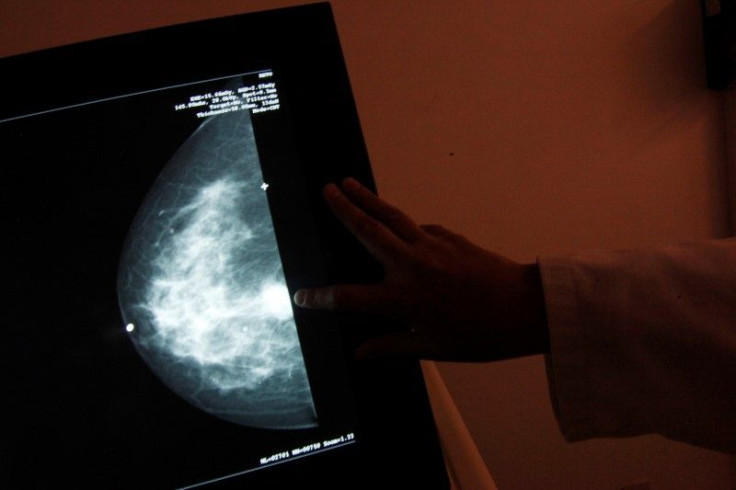New Breast Cancer Guidelines Recommend Average-Risk Women Get First Mammogram At Age 50; Why Wait?

A new study published in the Annals of Internal Medicine finds women with an average risk for breast cancer should get a mammography biennially (every two years) starting at age 50. The findings were presented to the U.S. Preventive Services Task Force (USPSTF) in an effort to come up with more effective screening programs.
In 2009, the USPSTF put forth its recommendation for biennial film mammography from age 50 to 74, as well as shared decision making about screening women in their 40s, the study authors wrote. But since then, new data has emerged regarding the benefits of screening programs, in addition to an "increasingly effective systemic treatment regiments for breast cancer have become standard" and consumer interest in more personalized screening approaches. In addition to evaluating the USPSTF's recommendations, the study authors examined how breast density, risk, and comorbidity levels affect mammography results.
They evaluated eight strategies differing in terms of screening start age (40, 45, and 50) and screening interval (annual, biennial, and hybrid). Hybrid interval means mammography screening is annual in your 40s, but biennial in the years thereafter. Study authors measured for screening benefits, such as breast cancer deaths averted and quality-adjusted life years; number of mammograms used; harms, like false positives; and ratios of harms and benefits per 1,000 screens. Authors also considered preferences, or utilities, to account for morbidity from screening and treatment.
Each strategy was ranked by the number of mammograms performed, study authors wrote. They report the median use, benefits, and harms and range across models. And the results revealed biennial strategies were consistently the most efficient for average-risk women; it yielded a median 25.8 percent reduction in breast cancer mortality compared with no screening.
Annual screening, on the other hand, led to slightly greater reductions in mortality than biennial strategies, study authors found — however, "biennial strategies maintained a median of 79.8 percent to 81.3 percent of the breast cancer-specific mortality reduction of annual screening."
"These new analyses include information not in our 2009 report," said lead study author Dr. Jeanne S. Mandelblatt, of Georgetown Lombardi Comprehensive Cancer Center and a principal investigator with the Cancer Intervention and Surveillance Modeling Network, in a press release. Mandelblatt added the new models used to test the efficacy of current standing programs "provide evidence that can be considered for public health recommendations for average risk women. But it's important to remember that none of us is the 'average' woman."
These findings are somewhat on par with the updated guidelines the American Cancer Society (ACS) released in October 2015, the ACS' first update since 2003. It's the ACS recommendation that those facing an average risk of breast cancer get their first mammogram at age 45, and do so annually until age 55. Women aged 55 and older should transition to biennial or hybrid screening, the ACS said.
When you think of breast cancer detection, you think the earlier, the better, right? Why would women wait to get screened?
For one, not everyone has access to regular mammograms, Susan G. Komen said in a statement. The breast cancer organization cited one-third of women who should be screened do not access these services, suggesting "we must take all steps necessary to ensure that women don't face economic or orther barriers when their health care providers recommend screening."
An even bigger reservation, though, has to do with the technology itself. More experts question whether mammograms are the best available tool for detecting breast cancer, which is why health care providers and committees suggest a delayed start date. Earlier and annual screenings have been shown to increase risk for a false-positive results, which could then lead to unnecessary treatment and health care-related costs. One study published in the journal Cancer Epidemiology, Biomarkers & Prevention found false-positives actually raised women's breast cancer risk for up to 10 years after the fact.
With the present study, while study authors acknowledged biennial screening beginning at age 40 instead of 50 would avert a median of one breast cancer death per every 1000 women, it would mean "576 more false-positive results, 67 more benign biopsies, and two additional overdiagnosed cases," too.
"Compared with screening initiation at age 45 years, starting screening at age 40 years had one or fewer added deaths averted depending on interval, but more incremental harms," they added.
It's frustrating to continually see new guidelines and new recommendations, we know. But breast cancer is still the most common cancer among women living in America, where about one in eight women will develop invasive breast cancer during their lifetime, according to the ACS. We need to experts to keep reviewing and evaluating programs currently in place to make sure women (and men) have everything they need when it comes to minimizing risk and finding effective treatment.
Mandelblatt concluded: "When women should start screening, and how often, ultimately, remains a personal decision."
Source: Mandelblatt J, et al. Collaborative Modeling of the Benefits and Harms Associated With Different U.S. Breast Cancer Screening Strategies. Annals of Internal Medicine. 2016.



























